外研版(2019)选择性必修第三册Unit 1 Face values Reading 课件 (共24张PPT)
文档属性
| 名称 | 外研版(2019)选择性必修第三册Unit 1 Face values Reading 课件 (共24张PPT) | 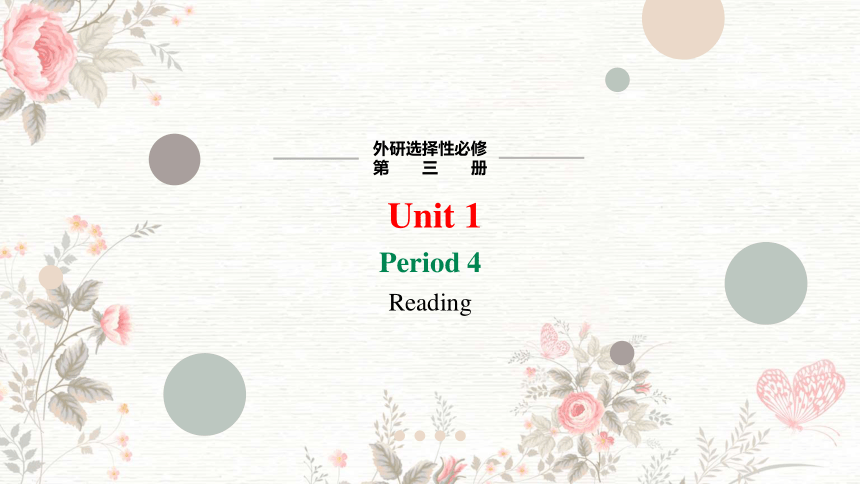 | |
| 格式 | pptx | ||
| 文件大小 | 6.4MB | ||
| 资源类型 | 教案 | ||
| 版本资源 | 外研版(2019) | ||
| 科目 | 英语 | ||
| 更新时间 | 2024-03-21 11:18:43 | ||
图片预览

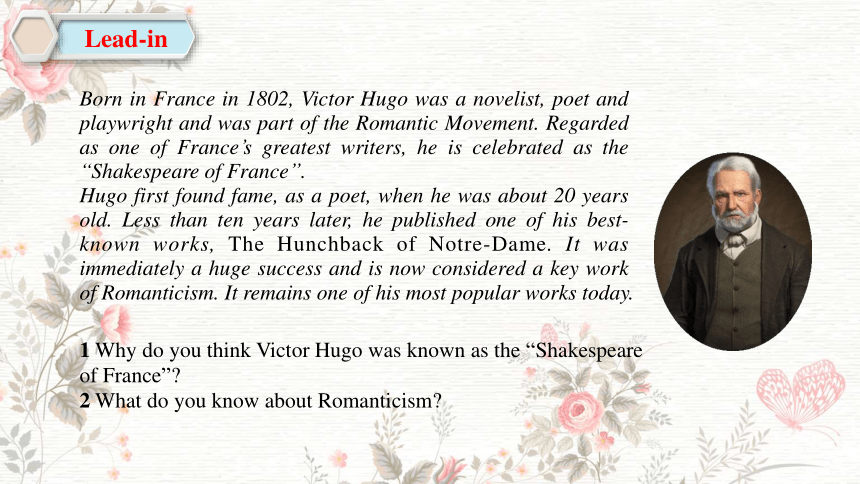
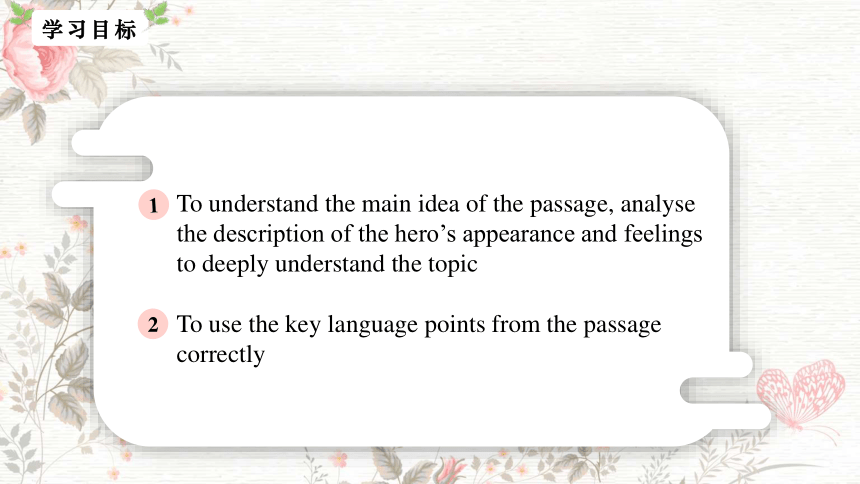
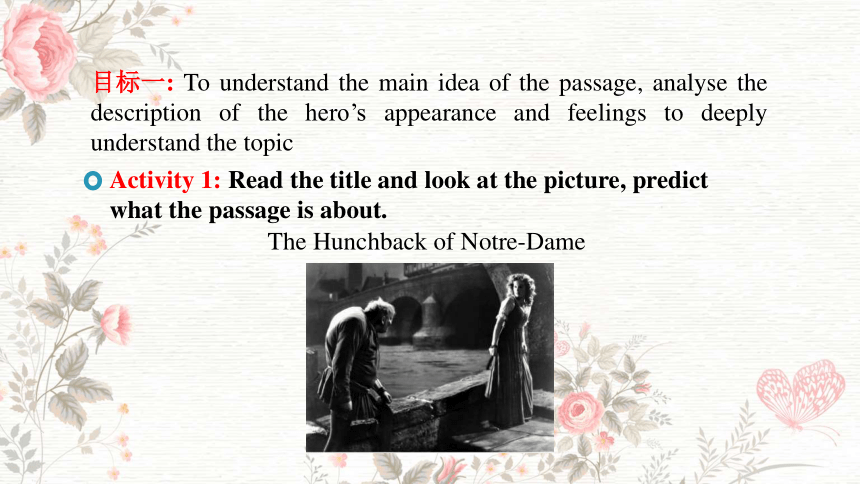
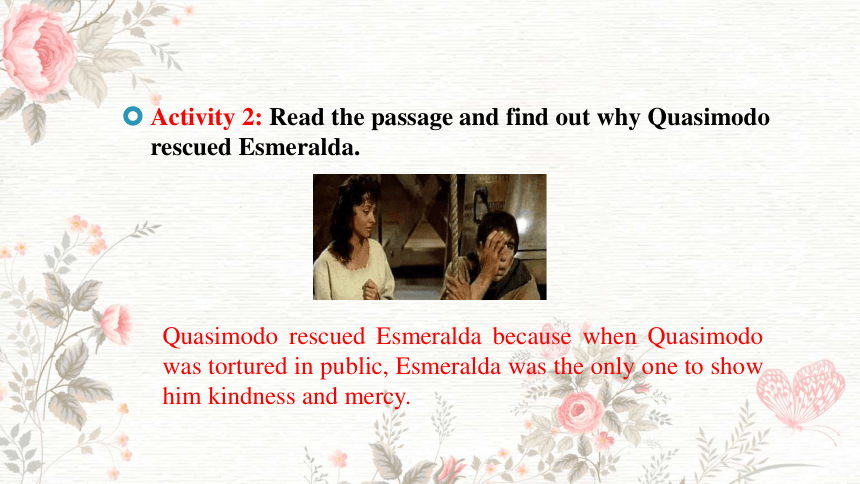
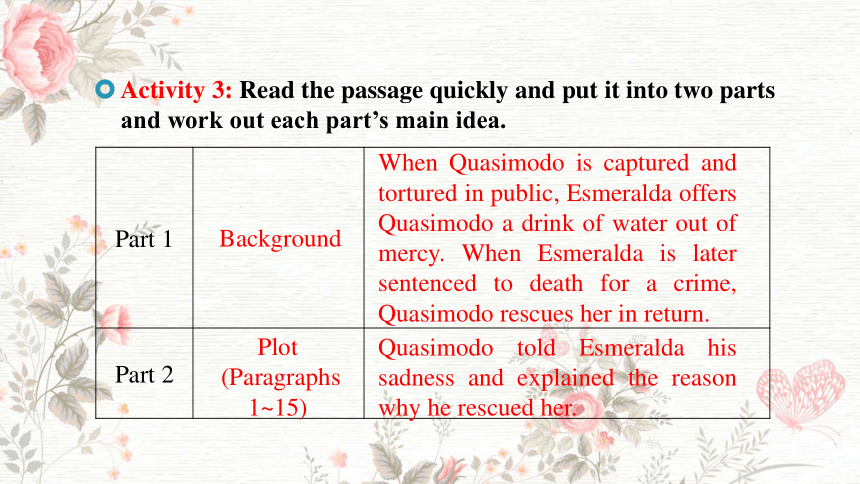
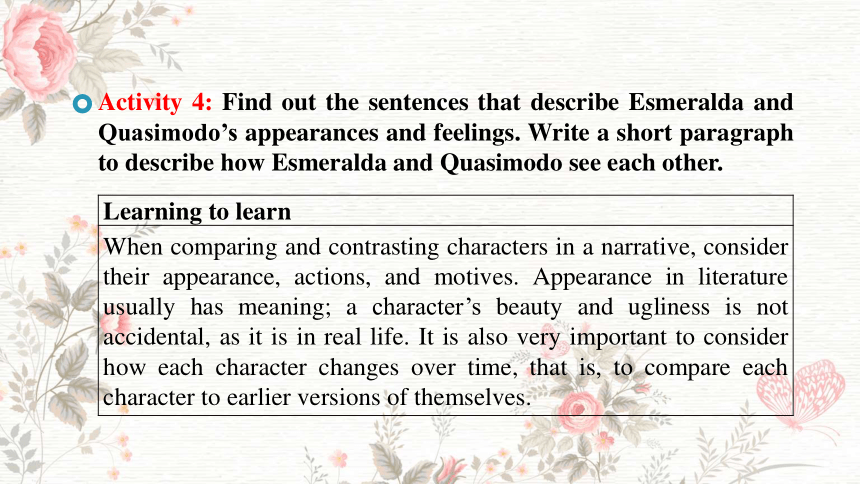
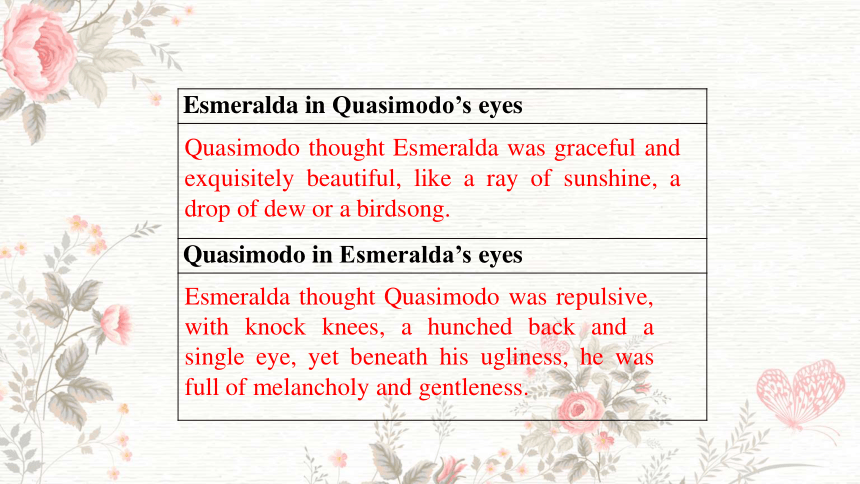
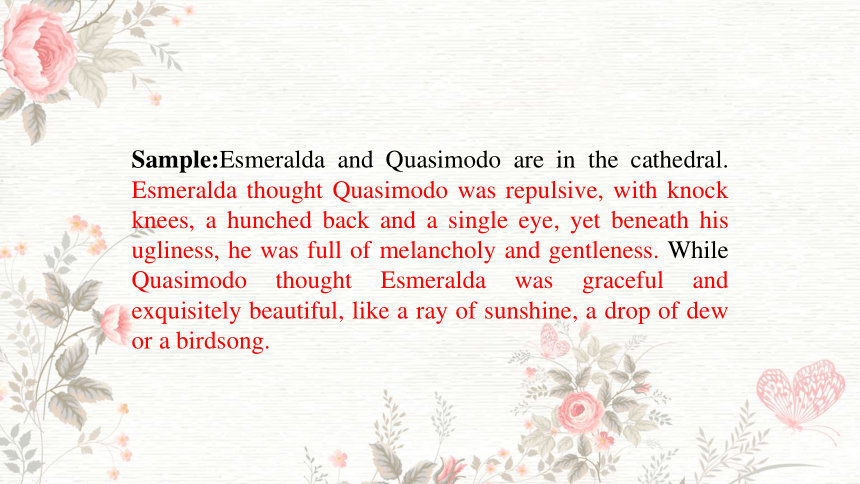
文档简介
(共24张PPT)
外研选择性必修
第三册
Unit 1
Period 4
Reading
教学目
Lead-in
Born in France in 1802, Victor Hugo was a novelist, poet and playwright and was part of the Romantic Movement. Regarded as one of France’s greatest writers, he is celebrated as the “Shakespeare of France”.
Hugo first found fame, as a poet, when he was about 20 years old. Less than ten years later, he published one of his best-known works, The Hunchback of Notre-Dame. It was immediately a huge success and is now considered a key work of Romanticism. It remains one of his most popular works today.
1 Why do you think Victor Hugo was known as the “Shakespeare of France”
2 What do you know about Romanticism
1
2
To understand the main idea of the passage, analyse the description of the hero’s appearance and feelings to deeply understand the topic
To use the key language points from the passage correctly
目标一: To understand the main idea of the passage, analyse the description of the hero’s appearance and feelings to deeply understand the topic
Activity 1: Read the title and look at the picture, predict what the passage is about.
The Hunchback of Notre-Dame
Activity 2: Read the passage and find out why Quasimodo rescued Esmeralda.
Quasimodo rescued Esmeralda because when Quasimodo was tortured in public, Esmeralda was the only one to show him kindness and mercy.
Activity 3: Read the passage quickly and put it into two parts and work out each part’s main idea.
Part 1
Part 2
Background
Plot
(Paragraphs 1~15)
When Quasimodo is captured and tortured in public, Esmeralda offers Quasimodo a drink of water out of mercy. When Esmeralda is later sentenced to death for a crime, Quasimodo rescues her in return.
Quasimodo told Esmeralda his sadness and explained the reason why he rescued her.
Activity 4: Find out the sentences that describe Esmeralda and Quasimodo’s appearances and feelings. Write a short paragraph to describe how Esmeralda and Quasimodo see each other.
Learning to learn
When comparing and contrasting characters in a narrative, consider their appearance, actions, and motives. Appearance in literature usually has meaning; a character’s beauty and ugliness is not accidental, as it is in real life. It is also very important to consider how each character changes over time, that is, to compare each character to earlier versions of themselves.
Esmeralda in Quasimodo’s eyes
Quasimodo in Esmeralda’s eyes
Quasimodo thought Esmeralda was graceful and exquisitely beautiful, like a ray of sunshine, a drop of dew or a birdsong.
Esmeralda thought Quasimodo was repulsive, with knock knees, a hunched back and a single eye, yet beneath his ugliness, he was full of melancholy and gentleness.
Sample:Esmeralda and Quasimodo are in the cathedral. Esmeralda thought Quasimodo was repulsive, with knock knees, a hunched back and a single eye, yet beneath his ugliness, he was full of melancholy and gentleness. While Quasimodo thought Esmeralda was graceful and exquisitely beautiful, like a ray of sunshine, a drop of dew or a birdsong.
Now work in pairs. Read the passage again and find out how Esmeralda’s feelings towards Quasimodo changed. Share your answers with your partner.
repulsive → compassion → profound tenderness
Activity 5: Think & Share
1 What does the sentence “A tear swam in the eye of Quasimodo, but did not fall” tell us about Quasimodo’s personality
2 In what different ways do the two reading passages in this unit raise our awareness of physical appearance and personal qualities
On one hand, it shows that Quasimodo is sensitive and gentle; on the other hand, it shows his strength and pride.
The first passage shows the true meaning of beauty. Though how you present yourself to others plays a part, accepting yourself and feeling confident about your physical appearance are most important. The second passage highlights how someone’s physical appearance can actually be a complete contrast to who they are on the inside.
3 What difficulties might people like Quasimodo face in the real world How should people treat them
4 Predict what happens next. Share your ideas with the class. Read the novel and check your prediction.
People may laugh at them, and they may not get some kinds of jobs. People should treat them equally.
Esmeralda accepts Quasimodo as he looks like. They live in the cathedral together.
Activity 6: Work in groups. Give a talk about the character in the passage that makes the greatest impression on you.
1 Organise your ideas by considering the questions.·What is the character like ·Has he / she experienced any emotional changes If so, what changes are they ·What can you learn from him / her 2 Present your ideas in your group.3 Collect all your group’s ideas and present them to the class.Now think about whether you can express yourself clearly or understand others in the group talk, and what your strengths or weaknesses are, compared to those of the others in your group.
目标二: To use the key language points from the passage correctly
Activity 1: Find the important words, phrases, and language points you want to share with your partner. Then discuss in groups and share their usage with the class.
1 capture one’s heart 俘获某人的心 be sentenced to death 被判处死刑commit a crime 犯罪She offers Quasimodo a drink of water, [1] which saves him and also captures his heart. When Esmeralda is later sentenced to death for a crime [2] she did not commit, Quasimodo rescues her from an angry crowd outside the Notre-Dame Cathedral. 她给卡西莫多一杯水,既救了他,也俘获了他的心。 当埃斯梅拉达后来因莫须有的罪名被判处死刑时,卡西莫多从圣母院外愤怒的人群中将她救了出来。【句型分析】[1]处为定语从句前面的整句话,[2]处为省略了that的定语从句
2 in silence 静静地 Esmeralda and Quasimodo were still for several moments, as they considered their predicament in silence, she so graceful, he so repulsive.埃斯梅拉达和卡西莫多沉默了好一会儿,他们默默地思考着他们的困境,她是那么优雅,他是那么令人厌恶。Paraphrase:Esmeralda and Quasimodo did not move or speak for several moments as they considered their difficult situation-she was so graceful and he was so repulsive.
【句型讲解】本句中she so graceful, he so repulsive的是独立主格结构。独立主格结构由两部分组成,前一部分是名词或者代词,后一部分是非谓语动词(又叫非限定动词)(动名词、不定式、现在分词、过去分词),形容词,副词或介词短语等。独立主格结构的前后两部分有逻辑上的主谓关系。独立主格结构在句子中可以作状语,表示时间、原因、条件、伴随的动作或情况等,多用于书面语。例如:She sat alone, tears rolling down her face.
本句中still作形容词,意为“安静的、平静的”
4 How anyone could be formed in such a way was beyond her comprehension.Paraphrase:She couldn’t understand how anyone could be formed in such a way.How anyone could be formed in such a way 是一个主语从句,作整个句子的主语。本句中的beyond意为“超出(理解或信任的范围)”。例如:What Mike had done was beyond my comprehension.(Mike所做的事让我无法理解。)此外,beyond还有“在……的那边”的意思。
例如:Beyond the river, cattle were grazing.(河的那边,牛在吃草。)
5 adjust to 适应【教材原文】Yet there was so much melancholy and so much gentleness spread over all this that she gradually adjusted to it.然而,在这一切之上,却弥漫着许多忧郁和温柔,她逐渐适应了这一切。【句型分析】本句中spread over all this作后置定语修饰melancholy, gentleness;句末that she gradually adjusted to it作结果状语;主句为There be句型。6 You suppose [1] that was all [2] that I was missing, do you not 【句型分析】本句为反义疑问句。陈述部分包含[1]that was all宾语从句,其中that指代deaf;[2]that I was missing定语从句。
7 an awareness of... ……的意识utter a syllable 说一个字【教材原文】 There lay in the accents of the unfortunate man so significant an awareness of his sadness that she had not the strength to utter a syllable.那个不幸的男人的口音里有一种意识到他悲伤的意味,以致于她连一个音节都说不出来。Paraphrase:She perceived such great sadness in the voice of the unfortunate man that she didn’t have the strength to say a word.【句型分析】 本句是一个由there引导的倒装句,是"there +不及物动词”结构。例如:There came a knock on the door.Once upon a time, there lived a fisherman on the island.句末 that she had not the strength to utter a syllable为结果状语从句。
8 compare...to... 把……和……相比【教材原文】When I compare myself to you, I feel an immense pity for myself, poor unfortunate monster that I am!当我把自己和你比较的时候,我对自己感到一种极大的同情,我是一个可怜的不幸的怪物!9 attempt to do sth. 企图做某事【教材原文】You have forgotten an unfortunate person [1] who attempted to kidnap you one night, this same person [2] to whom you showed kindness when he was being punished. 你忘了有个不幸的人某天晚上企图绑架你,就是这个人,你在他受到惩罚时对他表现出了善意。【句型分析】[1] who引导定语从句修饰person; [2] to whom引导定语从句修饰person;句末when he was being punished为时间状语从句,其中用了过去进行时的被动语态。
10 keep sth. at bay 阻止、遏制(令人不愉快的事物)【教材原文】He seemed to make it a point of honour to keep it at bay. Paraphrase:It seemed that he must stop his tear in order to preserve his honour.keep sth. at bay 是固定搭配,意为 to prevent something unpleasant from reaching, attacking, or affecting you “阻止,遏制(令人不愉快的事)”例如:A thick wall keeps the noise at bay.
Activity 2: Complete the summary with the correct words or the correct forms of the words in the bracket according to the passage.
The Hunchback of Notre-Dame which 1____________(publish) in 1831 tells a tragic story of events in Paris. Esmeralda’s beauty means that many men fall in love 2______ her. Quasimodo is sent 3___________(kidnap) Esmeralda, but Quasimodo fails and is captured and tortured 4________ public. Esmeralda hears his call for water. She offers Quasimodo a drink of water, 5___________ saves him as well as catches his heart. 6____________(late), when Esmeralda is sentenced to death for a crime she did not commit, Quasimodo rescues her from an angry crowd outside the Notre- Dame Cathedral.
was published
with
to kidnap
in
which
Later
Esmeralda is safe from execution as long as she stays inside the cathedral. They were still for several moments, as they considered their trouble in 7__________(silent). Although Esmeralda 8_____________(discover) some fresh defect in Quasimodo, there was so much melancholy and so much gentleness spread over all this that she ___________(gradual) adjusted to it . At last, Quasimodo told Esmeralda that he rescued her because he wanted to repay her for her 10_____________(kind) when he was being punished.
silence
discovered
gradually
kindness
1 Can you introduce Victor Hugo in your own words 2 Can you retell Quasimodo’s and Esmeralda’s descriptions of appearances and feelings on each other
外研选择性必修
第三册
Unit 1
Period 4
Reading
教学目
Lead-in
Born in France in 1802, Victor Hugo was a novelist, poet and playwright and was part of the Romantic Movement. Regarded as one of France’s greatest writers, he is celebrated as the “Shakespeare of France”.
Hugo first found fame, as a poet, when he was about 20 years old. Less than ten years later, he published one of his best-known works, The Hunchback of Notre-Dame. It was immediately a huge success and is now considered a key work of Romanticism. It remains one of his most popular works today.
1 Why do you think Victor Hugo was known as the “Shakespeare of France”
2 What do you know about Romanticism
1
2
To understand the main idea of the passage, analyse the description of the hero’s appearance and feelings to deeply understand the topic
To use the key language points from the passage correctly
目标一: To understand the main idea of the passage, analyse the description of the hero’s appearance and feelings to deeply understand the topic
Activity 1: Read the title and look at the picture, predict what the passage is about.
The Hunchback of Notre-Dame
Activity 2: Read the passage and find out why Quasimodo rescued Esmeralda.
Quasimodo rescued Esmeralda because when Quasimodo was tortured in public, Esmeralda was the only one to show him kindness and mercy.
Activity 3: Read the passage quickly and put it into two parts and work out each part’s main idea.
Part 1
Part 2
Background
Plot
(Paragraphs 1~15)
When Quasimodo is captured and tortured in public, Esmeralda offers Quasimodo a drink of water out of mercy. When Esmeralda is later sentenced to death for a crime, Quasimodo rescues her in return.
Quasimodo told Esmeralda his sadness and explained the reason why he rescued her.
Activity 4: Find out the sentences that describe Esmeralda and Quasimodo’s appearances and feelings. Write a short paragraph to describe how Esmeralda and Quasimodo see each other.
Learning to learn
When comparing and contrasting characters in a narrative, consider their appearance, actions, and motives. Appearance in literature usually has meaning; a character’s beauty and ugliness is not accidental, as it is in real life. It is also very important to consider how each character changes over time, that is, to compare each character to earlier versions of themselves.
Esmeralda in Quasimodo’s eyes
Quasimodo in Esmeralda’s eyes
Quasimodo thought Esmeralda was graceful and exquisitely beautiful, like a ray of sunshine, a drop of dew or a birdsong.
Esmeralda thought Quasimodo was repulsive, with knock knees, a hunched back and a single eye, yet beneath his ugliness, he was full of melancholy and gentleness.
Sample:Esmeralda and Quasimodo are in the cathedral. Esmeralda thought Quasimodo was repulsive, with knock knees, a hunched back and a single eye, yet beneath his ugliness, he was full of melancholy and gentleness. While Quasimodo thought Esmeralda was graceful and exquisitely beautiful, like a ray of sunshine, a drop of dew or a birdsong.
Now work in pairs. Read the passage again and find out how Esmeralda’s feelings towards Quasimodo changed. Share your answers with your partner.
repulsive → compassion → profound tenderness
Activity 5: Think & Share
1 What does the sentence “A tear swam in the eye of Quasimodo, but did not fall” tell us about Quasimodo’s personality
2 In what different ways do the two reading passages in this unit raise our awareness of physical appearance and personal qualities
On one hand, it shows that Quasimodo is sensitive and gentle; on the other hand, it shows his strength and pride.
The first passage shows the true meaning of beauty. Though how you present yourself to others plays a part, accepting yourself and feeling confident about your physical appearance are most important. The second passage highlights how someone’s physical appearance can actually be a complete contrast to who they are on the inside.
3 What difficulties might people like Quasimodo face in the real world How should people treat them
4 Predict what happens next. Share your ideas with the class. Read the novel and check your prediction.
People may laugh at them, and they may not get some kinds of jobs. People should treat them equally.
Esmeralda accepts Quasimodo as he looks like. They live in the cathedral together.
Activity 6: Work in groups. Give a talk about the character in the passage that makes the greatest impression on you.
1 Organise your ideas by considering the questions.·What is the character like ·Has he / she experienced any emotional changes If so, what changes are they ·What can you learn from him / her 2 Present your ideas in your group.3 Collect all your group’s ideas and present them to the class.Now think about whether you can express yourself clearly or understand others in the group talk, and what your strengths or weaknesses are, compared to those of the others in your group.
目标二: To use the key language points from the passage correctly
Activity 1: Find the important words, phrases, and language points you want to share with your partner. Then discuss in groups and share their usage with the class.
1 capture one’s heart 俘获某人的心 be sentenced to death 被判处死刑commit a crime 犯罪She offers Quasimodo a drink of water, [1] which saves him and also captures his heart. When Esmeralda is later sentenced to death for a crime [2] she did not commit, Quasimodo rescues her from an angry crowd outside the Notre-Dame Cathedral. 她给卡西莫多一杯水,既救了他,也俘获了他的心。 当埃斯梅拉达后来因莫须有的罪名被判处死刑时,卡西莫多从圣母院外愤怒的人群中将她救了出来。【句型分析】[1]处为定语从句前面的整句话,[2]处为省略了that的定语从句
2 in silence 静静地 Esmeralda and Quasimodo were still for several moments, as they considered their predicament in silence, she so graceful, he so repulsive.埃斯梅拉达和卡西莫多沉默了好一会儿,他们默默地思考着他们的困境,她是那么优雅,他是那么令人厌恶。Paraphrase:Esmeralda and Quasimodo did not move or speak for several moments as they considered their difficult situation-she was so graceful and he was so repulsive.
【句型讲解】本句中she so graceful, he so repulsive的是独立主格结构。独立主格结构由两部分组成,前一部分是名词或者代词,后一部分是非谓语动词(又叫非限定动词)(动名词、不定式、现在分词、过去分词),形容词,副词或介词短语等。独立主格结构的前后两部分有逻辑上的主谓关系。独立主格结构在句子中可以作状语,表示时间、原因、条件、伴随的动作或情况等,多用于书面语。例如:She sat alone, tears rolling down her face.
本句中still作形容词,意为“安静的、平静的”
4 How anyone could be formed in such a way was beyond her comprehension.Paraphrase:She couldn’t understand how anyone could be formed in such a way.How anyone could be formed in such a way 是一个主语从句,作整个句子的主语。本句中的beyond意为“超出(理解或信任的范围)”。例如:What Mike had done was beyond my comprehension.(Mike所做的事让我无法理解。)此外,beyond还有“在……的那边”的意思。
例如:Beyond the river, cattle were grazing.(河的那边,牛在吃草。)
5 adjust to 适应【教材原文】Yet there was so much melancholy and so much gentleness spread over all this that she gradually adjusted to it.然而,在这一切之上,却弥漫着许多忧郁和温柔,她逐渐适应了这一切。【句型分析】本句中spread over all this作后置定语修饰melancholy, gentleness;句末that she gradually adjusted to it作结果状语;主句为There be句型。6 You suppose [1] that was all [2] that I was missing, do you not 【句型分析】本句为反义疑问句。陈述部分包含[1]that was all宾语从句,其中that指代deaf;[2]that I was missing定语从句。
7 an awareness of... ……的意识utter a syllable 说一个字【教材原文】 There lay in the accents of the unfortunate man so significant an awareness of his sadness that she had not the strength to utter a syllable.那个不幸的男人的口音里有一种意识到他悲伤的意味,以致于她连一个音节都说不出来。Paraphrase:She perceived such great sadness in the voice of the unfortunate man that she didn’t have the strength to say a word.【句型分析】 本句是一个由there引导的倒装句,是"there +不及物动词”结构。例如:There came a knock on the door.Once upon a time, there lived a fisherman on the island.句末 that she had not the strength to utter a syllable为结果状语从句。
8 compare...to... 把……和……相比【教材原文】When I compare myself to you, I feel an immense pity for myself, poor unfortunate monster that I am!当我把自己和你比较的时候,我对自己感到一种极大的同情,我是一个可怜的不幸的怪物!9 attempt to do sth. 企图做某事【教材原文】You have forgotten an unfortunate person [1] who attempted to kidnap you one night, this same person [2] to whom you showed kindness when he was being punished. 你忘了有个不幸的人某天晚上企图绑架你,就是这个人,你在他受到惩罚时对他表现出了善意。【句型分析】[1] who引导定语从句修饰person; [2] to whom引导定语从句修饰person;句末when he was being punished为时间状语从句,其中用了过去进行时的被动语态。
10 keep sth. at bay 阻止、遏制(令人不愉快的事物)【教材原文】He seemed to make it a point of honour to keep it at bay. Paraphrase:It seemed that he must stop his tear in order to preserve his honour.keep sth. at bay 是固定搭配,意为 to prevent something unpleasant from reaching, attacking, or affecting you “阻止,遏制(令人不愉快的事)”例如:A thick wall keeps the noise at bay.
Activity 2: Complete the summary with the correct words or the correct forms of the words in the bracket according to the passage.
The Hunchback of Notre-Dame which 1____________(publish) in 1831 tells a tragic story of events in Paris. Esmeralda’s beauty means that many men fall in love 2______ her. Quasimodo is sent 3___________(kidnap) Esmeralda, but Quasimodo fails and is captured and tortured 4________ public. Esmeralda hears his call for water. She offers Quasimodo a drink of water, 5___________ saves him as well as catches his heart. 6____________(late), when Esmeralda is sentenced to death for a crime she did not commit, Quasimodo rescues her from an angry crowd outside the Notre- Dame Cathedral.
was published
with
to kidnap
in
which
Later
Esmeralda is safe from execution as long as she stays inside the cathedral. They were still for several moments, as they considered their trouble in 7__________(silent). Although Esmeralda 8_____________(discover) some fresh defect in Quasimodo, there was so much melancholy and so much gentleness spread over all this that she ___________(gradual) adjusted to it . At last, Quasimodo told Esmeralda that he rescued her because he wanted to repay her for her 10_____________(kind) when he was being punished.
silence
discovered
gradually
kindness
1 Can you introduce Victor Hugo in your own words 2 Can you retell Quasimodo’s and Esmeralda’s descriptions of appearances and feelings on each other
